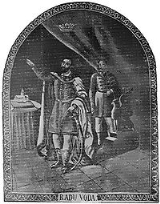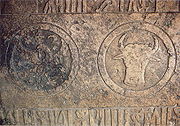
Radu Mihnea
Encyclopedia


Wallachia
Wallachia or Walachia is a historical and geographical region of Romania. It is situated north of the Danube and south of the Southern Carpathians...
between September 1601 and March 1602, and again between March and May 1611, September 1611 and August 1616, August 1620 and August 1623, and Voivode (Prince) of Moldavia
Moldavia
Moldavia is a geographic and historical region and former principality in Eastern Europe, corresponding to the territory between the Eastern Carpathians and the Dniester river...
in 1616-1619, 1623-1626. He was the illegitimate son of Mihnea Turcitul
Mihnea Turcitul
Mihnea II Turcitul was Prince of Walachia between September 1577 and July 1583, and again from April 1585 to May 1591....
by Voica Bratcul.
Modern-style prince & Family Man
Radu Mihnea spent part of his early years in Koper (Capodistria), on Mount AthosMount Athos
Mount Athos is a mountain and peninsula in Macedonia, Greece. A World Heritage Site, it is home to 20 Eastern Orthodox monasteries and forms a self-governed monastic state within the sovereignty of the Hellenic Republic. Spiritually, Mount Athos comes under the direct jurisdiction of the...
and in Greece. His stay in the Serenissima
Republic of Venice
The Republic of Venice or Venetian Republic was a state originating from the city of Venice in Northeastern Italy. It existed for over a millennium, from the late 7th century until 1797. It was formally known as the Most Serene Republic of Venice and is often referred to as La Serenissima, in...
accounts for the pro-Venetian character of his rule, and his interest in reforming the institutions of Wallachia and Moldavia. After completing his studies in Istanbul, Radu became prince of Wallachia at a very important time in Romanian history: following the union of the three principalities of Wallachia, Moldavia, and Transylvania under Michael the Brave. Radu would rule no less than four times in Wallachia and twice in Moldavia. He was loved due to his Renaissance-style and love of the arts. This was due to his upbringing by the monks of Iveron at Mount Athos, Greece. Radu Mihnea died in 1626 in Moldavia, and his body was carried to Bucharest and interred at the Church of Prince Radu. The monastery was protected by the monks of Mount Athos due to Radu's divine loyalty to his educators. Radu and his wife Arghira had five children, three boys and two girls. These five would be the last surviving direct descendants of Vlad III Dracula. The eldest was Alexandru Coconul
Alexandru Coconul
Alexandru Coconul was Hospodar and Voivode of Wallachia from 1623 to 1627 and Hospodar of Moldavia from 1629 to 1630. He was the son of Radu Mihnea, who also was a Hospodar. He married Ruxandra Beglitzi. He was the last of Vlad III Dracula's Romanian bloodline. He died on June 26, 1632 in Istanbul...
.
He replaced Polish
Polish-Lithuanian Commonwealth
The Polish–Lithuanian Commonwealth was a dualistic state of Poland and Lithuania ruled by a common monarch. It was the largest and one of the most populous countries of 16th- and 17th‑century Europe with some and a multi-ethnic population of 11 million at its peak in the early 17th century...
vassal
Vassal
A vassal or feudatory is a person who has entered into a mutual obligation to a lord or monarch in the context of the feudal system in medieval Europe. The obligations often included military support and mutual protection, in exchange for certain privileges, usually including the grant of land held...
Simion Movilă
Simion Movila
Simion Movilă, a boyar of the Movileşti family, was twice Prince of Wallachia and Prince of Moldavia on one occasion ....
on the throne in Bucharest
Bucharest
Bucharest is the capital municipality, cultural, industrial, and financial centre of Romania. It is the largest city in Romania, located in the southeast of the country, at , and lies on the banks of the Dâmbovița River....
after the brief occupation of Wallachia by the troops of hetman
Hetman
Hetman was the title of the second-highest military commander in 15th- to 18th-century Poland and the Grand Duchy of Lithuania, which together, from 1569 to 1795, comprised the Polish-Lithuanian Commonwealth, or Rzeczpospolita....
s Jan Zamoyski
Jan Zamoyski
Jan Zamoyski , was a Polish-Lithuanian nobleman, magnate, 1st duke/ordynat of Zamość. Royal Secretary since 1566, Lesser Kanclerz ) of the Crown since 1576, Lord Grand-Chancellor of the Crown since 1578, and Grand Hetman of the Crown since 1581...
and Jan Karol Chodkiewicz
Jan Karol Chodkiewicz
Jan Karol Chodkiewicz was a famous Lithuanian military commander and one of the most prominent noblemen of the Polish-Lithuanian Commonwealth.-Biography:...
. His first rule in the country signified the return to Ottoman
Ottoman Empire
The Ottoman EmpireIt was usually referred to as the "Ottoman Empire", the "Turkish Empire", the "Ottoman Caliphate" or more commonly "Turkey" by its contemporaries...
control, interrupted since Michael the Brave.
Radu appears to have been interested in a joint rule over Wallachia and Moldavia, and he came closest to achieving it when his third rule over Moldavia was doubled by the reign of son Alexandru Coconul
Alexandru Coconul
Alexandru Coconul was Hospodar and Voivode of Wallachia from 1623 to 1627 and Hospodar of Moldavia from 1629 to 1630. He was the son of Radu Mihnea, who also was a Hospodar. He married Ruxandra Beglitzi. He was the last of Vlad III Dracula's Romanian bloodline. He died on June 26, 1632 in Istanbul...
in Wallachia. The subtlety of this gesture is discarded in several sources:
- Radulo, who is nowadays Prince in Moldavia, and his son [who is Prince] in Wallachia, [the latter] being very young and overseen by his father (Venetian document of April 11, 1625).
- Radulo Voivode, Prince of Wallachia and Moldavia (various documents).
- Radu Mihnea's tombstone bears the carving of both countries' seals.

